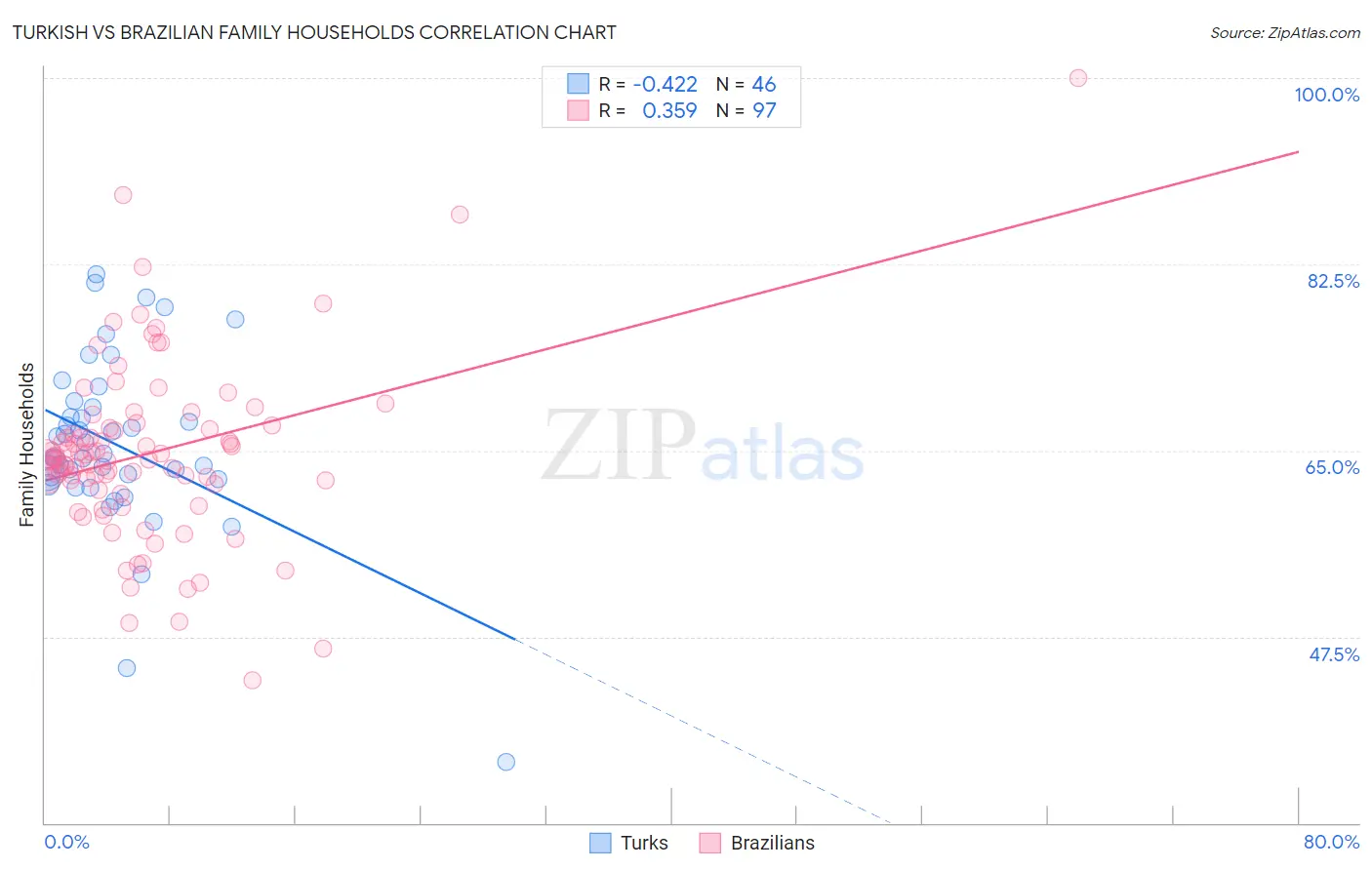Turkish vs Brazilian Family Households
COMPARE
Turkish
Brazilian
Family Households
Family Households Comparison
Turks
Brazilians
63.6%
FAMILY HOUSEHOLDS
4.5/ 100
METRIC RATING
224th/ 347
METRIC RANK
63.9%
FAMILY HOUSEHOLDS
12.4/ 100
METRIC RATING
205th/ 347
METRIC RANK
Turkish vs Brazilian Family Households Correlation Chart
The statistical analysis conducted on geographies consisting of 271,710,288 people shows a moderate negative correlation between the proportion of Turks and percentage of family households in the United States with a correlation coefficient (R) of -0.422 and weighted average of 63.6%. Similarly, the statistical analysis conducted on geographies consisting of 323,732,843 people shows a mild positive correlation between the proportion of Brazilians and percentage of family households in the United States with a correlation coefficient (R) of 0.359 and weighted average of 63.9%, a difference of 0.38%.

Family Households Correlation Summary
| Measurement | Turkish | Brazilian |
| Minimum | 35.7% | 43.4% |
| Maximum | 81.5% | 100.0% |
| Range | 45.8% | 56.6% |
| Mean | 65.5% | 64.7% |
| Median | 64.5% | 64.2% |
| Interquartile 25% (IQ1) | 62.3% | 61.5% |
| Interquartile 75% (IQ3) | 69.1% | 67.3% |
| Interquartile Range (IQR) | 6.8% | 5.8% |
| Standard Deviation (Sample) | 8.4% | 8.5% |
| Standard Deviation (Population) | 8.3% | 8.4% |
Demographics Similar to Turks and Brazilians by Family Households
In terms of family households, the demographic groups most similar to Turks are Immigrants from Belarus (63.7%, a difference of 0.070%), French Canadian (63.7%, a difference of 0.070%), Immigrants from South Africa (63.7%, a difference of 0.10%), Macedonian (63.7%, a difference of 0.13%), and Immigrants from Europe (63.7%, a difference of 0.13%). Similarly, the demographic groups most similar to Brazilians are Immigrants from Uruguay (63.9%, a difference of 0.010%), Immigrants from Lithuania (63.9%, a difference of 0.010%), Nigerian (63.9%, a difference of 0.030%), Immigrants from Bangladesh (63.9%, a difference of 0.030%), and Sierra Leonean (63.9%, a difference of 0.040%).
| Demographics | Rating | Rank | Family Households |
| Immigrants | Uruguay | 12.8 /100 | #204 | Poor 63.9% |
| Brazilians | 12.4 /100 | #205 | Poor 63.9% |
| Immigrants | Lithuania | 12.1 /100 | #206 | Poor 63.9% |
| Nigerians | 11.5 /100 | #207 | Poor 63.9% |
| Immigrants | Bangladesh | 11.4 /100 | #208 | Poor 63.9% |
| Sierra Leoneans | 11.2 /100 | #209 | Poor 63.9% |
| Immigrants | Thailand | 9.6 /100 | #210 | Tragic 63.8% |
| Shoshone | 9.4 /100 | #211 | Tragic 63.8% |
| Immigrants | Netherlands | 9.4 /100 | #212 | Tragic 63.8% |
| Immigrants | Northern Europe | 8.8 /100 | #213 | Tragic 63.8% |
| Celtics | 8.0 /100 | #214 | Tragic 63.8% |
| Belgians | 7.6 /100 | #215 | Tragic 63.8% |
| Croatians | 7.3 /100 | #216 | Tragic 63.8% |
| Osage | 7.0 /100 | #217 | Tragic 63.7% |
| Marshallese | 6.9 /100 | #218 | Tragic 63.7% |
| Macedonians | 6.5 /100 | #219 | Tragic 63.7% |
| Immigrants | Europe | 6.4 /100 | #220 | Tragic 63.7% |
| Immigrants | South Africa | 5.9 /100 | #221 | Tragic 63.7% |
| Immigrants | Belarus | 5.5 /100 | #222 | Tragic 63.7% |
| French Canadians | 5.4 /100 | #223 | Tragic 63.7% |
| Turks | 4.5 /100 | #224 | Tragic 63.6% |